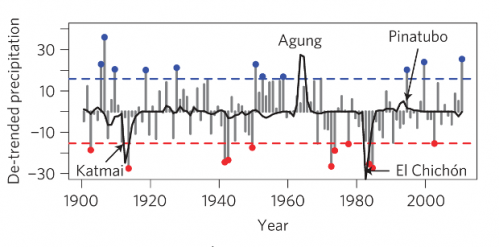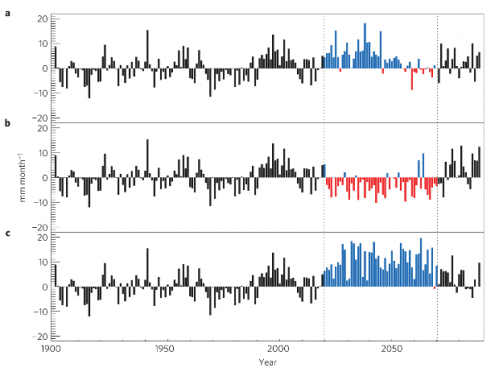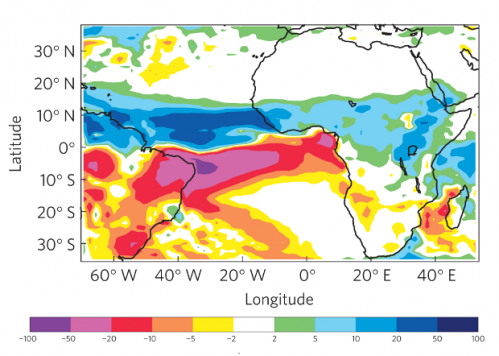Stratospheric aerosols and their impact on Sahelian rainfall

(Phys.org) —The Sahelian drought of the 1970s-1990s was one of the largest humanitarian disasters of the last fifty years, causing up to 250,000 deaths and creating 10 million refugees. This drought has been attributed to natural variability, over-grazing and the impact of industrial emissions of sulphur dioxide. Each of these mechanisms can influence the Atlantic sea surface temperature gradient which is strongly coupled to Sahelian precipitation.
A new study by Jim Haywood and colleagues strongly suggests that sporadic volcanic eruptions in the northern hemisphere also strongly influence the sea surface temperature gradient and cause Sahelian drought.
The Met Office Earth System coupled ocean-atmosphere model (HadGEM2-ES) has been used to simulate two instances of these eruptions - Katmai in 1912 and El Chichón in 1982 which hurled millions of tons of sulphur dioxide high up into the northern hemisphere stratosphere. Once in the stratosphere, the sulphur dioxide is gradually converted into sulphuric acid particles which reflect sunlight back to space and lead to a cooling of the Earth's surface in the northern hemisphere relative to the southern hemisphere.
Figure 1 shows observations of the detrended Sahelian precipitation anomalies: in years 1913, 1982, and 1983, significant droughts exist immediately subsequent to the volcanic Katmai and El Chichón eruptions.
Haywood et al. (2013) show that the HadGEM2-ES coupled atmosphere ocean model is able to accurately predict the impact of volcanic eruptions on Sahelian rainfall, which suggests that accurate predictions of droughts in the Sahel should be possible subsequent to future volcanic eruptions, with obvious implications for disaster relief and aid agencies.
The study then goes further by modelling the impacts of continuous deliberate injection of sulphur dioxide into the stratosphere, which has been suggested as a potentially plausible measure to counterbalance the impacts of global warming. Results suggest deliberate unilateral aerosol injection into the northern hemisphere causes significant drought in the Sahel, while injection into the southern hemisphere causes a significant greening as shown in Figure 2.

While on the face of it, this suggests that one could potentially inject into the southern hemisphere to make the Sahel a more hospitable and agriculturally viable region, Haywood et al (2013) stress that other areas of the Earth have to be considered. While there is a large increase in rainfall over much of the Sahel and the African continent (Figure 3), there is a sharp decrease in rainfall over the Norde-Est and Amazonian regions of Brazil which could have disastrous consequences for these regions.

The study goes on to show that if injections are balanced into both the northern and southern hemispheres, then major shifts in the monsoon circulation are avoided suggesting that unilateral injection into either hemisphere should not be contemplated. However, the emerging consensus from this and other studies is that so-called 'solar radiation management' schemes cannot simply counterbalance the impacts of global warming. There are always residual regional climate impacts leading to regional 'winners and losers'. This suggests that solar practical radiation management geoengineering would require consensual global governance.
More information: Haywood, J., Jones, A., Bellouin, N and Stephenson, D., Asymmetric forcing from stratospheric aerosols impacts Sahelian rainfall, Nature Climate Change, 2013. www.nature.com/nclimate/journa … ll/nclimate1857.html
Journal information: Nature Climate Change
Provided by UK Met Office
















